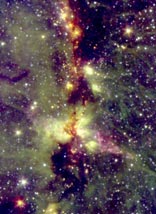 |
 |
| Weekly Science Update | ||||
|
Standard Candles - In 1929, Edwin Hubble discovered that galaxies are moving away from us by his observations of their Cepheid stars. Harvard astronomer Henrietta Swan Leavitt had found that a Cepheid star's period is related to its intrinsic luminosity, and she calibrated the effect so that a comparison of the calculated and observed luminosity of a Cepheid could determine its distance -- and Hubble did just that. But even today, the Hubble Space Telescope can only see Cepheid stars that are closer than about a hundred million light-years away, a small fraction of the size of the visible universe (currently about 40 billion light-years). Supernovae - the explosive deaths of massive stars - have provided a way to extend these Cepheid measurements. The most reliable supernovae for this purpose, because of their presumed cosmic uniformity, are so-called "Type Ia" supernovae. They are thought to be "standard candles" because they all seem to be of about the same intrinsic brightness, and so their visible brightness has been used to measure the distances of objects so far away that their light has been traveling for about half of the age of the universe. Astronomers realize, however, that many effects might confuse the accurate calibration of a distant Type Ia supernova. Dust extinction, in particular, would block some light and make it appear fainter (and hence more distant) than it actually is. Writing in this month's Astrophysical Journal, a team of ten CfA astronomers led by Michal Wood-Vasey, together with four colleagues, has pioneered what appears to be a practical solution to this problem. The astronomers observed twenty-one Type Ia SN in 1087 measurements made over ten years in the near infrared using the 1.3-meter PAIRITEL telescope at CfA's Fred L. Whipple Observatory in Arizona. Dust obscuration at infrared wavelengths is known to be much less severe than at visible wavelengths. When the team compared the infrared brightness measurements of these supernovae to the optical ones, and to models of supernovae behavior, they found that the infrared values were considerably more reliable, and had smaller uncertainties, than the optical data. Now that the team has established the value of infrared measurements, future cosmological measurements can be made with increased precision and increased reliability. | ||||

|
|